The Boxer - Who doesn't fall in love with their wrinkled, worried faces? Their imposing stares, noble posture and jaunty gait? Don’t be fooled because behind that stern facade lies one of the friendliest, most playful and loyal breeds Bark Busters has ever had the pleasure to train.
And training they will need!

Boxers are highly energetic and without consistent mental and physical stimulation, they can get into a lot of trouble! They love to jump on people, so it's important to break this behaviour as soon as possible. As they are so people oriented, they do not like being left alone, so separation anxiety can always be an issue.
Boxers are muscular and of medium size, weighing between 22 to 35 kgs and generally live 11 – 13 years. Their colouring is generally fawn, brindle, or white. About 25% of Boxers are white, often with coloured markings called "Checker Boxers". It is a misconception that white Boxers are less healthy than other colours of Boxers and always deaf because only 14% are born deaf.
In other countries, many Boxers have docked tails and cropped ears, although it is becoming more common for pet parents to not crop the Boxer's ears and just let them hang down. It is also illegal to crop a dog's ears and tail in the UK, unless it is for health reasons.
If a Boxer is joining your family, know that their intelligence, courage, and easy-going nature makes them a great family dog, but do not be mistaken, you will need lots of patience and you will need to do plenty of training too.
History
Boxer dogs originated in Germany and were bred as bullbaiting dogs and then butcher's helpers, assisting in controlling cattle in slaughterhouses. They descended from a long line of "Bullenbeisser" breeds (bull biters) that were used to hunt wild boar, bears, and bison, on large estates. Boxers were eventually bred with Bulldogs, Mastiffs and even Great Danes to form the dog that we all love today.
Boxers were invaluable in the World Wars carrying ammunition, messages, and supplies. Some of the soldiers fell in love with the dogs and brought them home with them. They were also one of the first dogs to be used as Police dogs too.
There are various theories about the origin of their name. Some say it comes from the German word 'boxl' (nickname for one of the Boxer's ancestors), whereas others think it comes from the way they use their paws to spar like a boxer in the ring.
The first Boxer dog arrived in Australia from England in 1948 and since then has become extremely popular. The Boxer is the ninth most popular dog breed in Australia and at one time was the most popular dog breed in the USA.

Management
Boxers are unique in that they don't fully mature until around three years of age, meaning their puppyhood seems to go on forever!
Boxers can be stubborn dogs, so they require strong leadership. Early training is important before your Boxer gets too big. Like many of the bull breeds, Boxers do not train well when using physical or harsh methods or being bossed around. Instead, with methods like Bark Busters uses, Boxers respond better to their leaders after you have earned their respect.
Dogs learn how to communicate with each other at their mother's teat. They use voice tones such as growling, barking, yipping, and their body language such as, their stance, position of tail, ears, etc. Therefore, it is best to use this same method of communication when dealing with your Boxer. Mother dogs speak dog and teach their pups the law according to the dog.
Boxers don't tolerate the heat too well, so walks during the cooler times of the day are best. They don't like extreme cold temperatures either because of their short coat, so a doggie coat might be the ideal thing for your Boxer if you live in a cold climate. They do much better at room temperature.

Personality and Temperament
Boxers love to play, and they make great family companions by displaying the utmost in love and loyalty. Even though they are not small, they often think they are lapdogs! When they get excited, they do a little dance called a 'kidney bean' where they twist their bodies into a semi-circle or even a full circle. They also make a special sound called a "woo woo" when excited. Owners of Boxers know what we're talking about!
They can be headstrong, meaning you will need to have patience when training them. They can become overexuberant and in their zest to protect their family, can lead to some aggression, so training in good doggie manners, is definitely advised.

Early socialisation is important, so they become exposed to different sights and experiences. Exercise is key to keep their energy levels in check. The Boxer is a big dog and can do a lot of damage if he's bored or lonely.
Capabilities of the Breed
Boxers are excellent guard dogs and have an above average IQ, making them diverse in the roles they can play. Boxers love to be active and are perfect for agility, obedience and flyball too.
Well socialised Boxers are the best! You want your Boxer dog to react calmly to sights and sounds in the world. Unsocialised Boxers can often develop fears and phobias that can be hard to undo.
Health
Your Boxer's health concerns will change over the course of their life. A puppy might be more prone to eating something they shouldn't, a 2-year-old Boxer is more likely to develop a cancerous mass, and a senior Boxer may develop urinary tract infections as they age. Boxers also have personality and physical traits that may make them more prone to certain conditions. They are prone to heart conditions as they age and tend to be active dogs that can injure themselves when playing or running.
If you are ever concerned about your dog's health, your local veterinarian is a great resource, no matter how small the question.
Genetic Health Concerns
Like many popular breeds, the Boxer has a number of hereditary health issues, such as eye conditions and heart problems. Boxers are also susceptible to allergies and multiple types of cancer. Most reputable breeders now have their breeding stock checked and scored for these hereditary ailments by a vet. You can request proof that the puppy you are purchasing comes from parents that have been checked for these issues.
Many other health issues are also hereditary, so do some research on the ancestry of your puppy and any health issues of that particular breed.
Many rescue organisations also check for common ailments before making them available for adoption.
Training Your Boxer

Bark Busters National Trainer - Jeff Drier on Boxers
It's not true that these dogs were so named because they stand up on their back legs like kangaroos and "box" with their front feet, although I might start that rumour. As a trainer for 15 years, I have worked with many Boxers and there are some things that I can generalise.
They have the greatest facial expressions. I love their expressiveness and if there is a dog that wears its feelings on its face it is the Boxer.
They are energetic and will be great companions if you are working towards running a marathon. They will not be as helpful if you are working on a crossword puzzle championship or doing a jigsaw puzzle. That's not to say that they can't stay quiet and still, but they can't stay quiet and still for long. As I said they are energetic.
They bounce, pounce and jump. Do you remember the rubber superballs? Those were the hard rubber balls that bounced higher and longer than any other ball? Boxers are the superballs of the dog world. They WILL greet you by jumping up on you unless you are very determined. Counter-surfing is also a common issue with them, once they realise they can reach the counters.
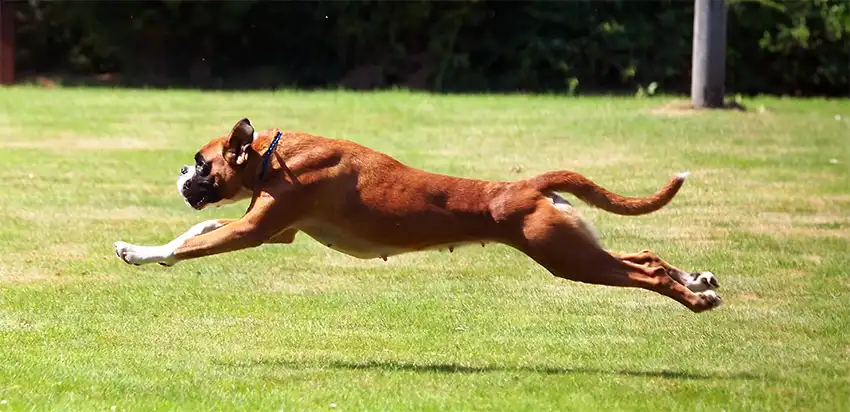
They are very intelligent, friendly, easy to train from a young age, and typically fun-loving. They are happy to participate in any physical activities, and the more strenuous the better. If you want a frisbee chaser you cannot pick a better breed. They live to run, and jump. If you are a hurdler, Boxers will adopt you immediately and will give you a great home.
If they aren't given outlets for their high energy, they will develop their own outlets which probably won't be what you want them to do.
They are very affectionate with their family but can be a little wary of strangers and visitors, so leadership is vital in keeping that under control. They can play rough so interactions with children need close monitoring. They don't mean to hurt anyone but often they get carried away and they don't know their own strength.
These are all breed generalisations and there are certainly Boxers that don't fit these descriptions, but most of the Boxers I've worked with do resemble the above. Bark Busters methodology makes it easy to teach your dog, even Boxers, how to be great family members. Love, trust, and respect are necessary elements of a great relationship and all those grow from understanding and clear communication. This is where Bark Busters excel in teaching our clients what their dogs are looking for and how to provide the leadership and structure that dogs instinctively seek. If you have issues with your Boxer or any other breed, contact your local trainer for assistance. You and your dog will be happy you did.
For more information about Bark Busters training or to book a lesson, find your local dog trainer here...
Behaviour Problems
Boxer puppies need socialisation as early as possible, this strong leadership. Boxers need to be positively motivated, and they love praise. Establishing yourself as a strong leader, and providing a consistent and structured environment, goes a long way with a Boxer dog.
Our dogs wan to please us but sometimes they just don't know how to do that. They will challenge your leadership if you are not being a strong leader. Earing their respect, and vice versa, is key to successful training.
Boxers tend to have a mind of their own. They don't like to be left alone, so separation anxiety can be a problem. They respond best to structured and fun training to help overcome their jumping, biting, barking and other misbehaviours. Positive reinforcement with praise should be a major part of your training programme.
An essential part of your training must involve exercise. Due to their high energy levels, a rousing game of fetch, or a long walk daily is a good idea. A bored dog can be a mischievous dog.
Separation Anxiety
Some Boxers don't do well when left home alone. They just don't like solitude, especially if their doggie parents have never prepared them for it.
Things like leaving the home for a few minutes, but staying close by, to gauge your Boxers reaction to being left alone is essential in early puppyhood.
Leaving durable toys or treat dispensing toys with your dog can help break the boredom, but sometimes they just want you.
This might sound great since anyone wants to be loved by their dog. However, the problem is that you may never be able to leave your dog at home alone while you go out to the movies or a meal.
Contact your local Bark Busters trainer for more info on dealing with Separation Anxiety.

Jumping Up
Jumping up can be a real problem with Boxers. Most Boxers love to greet anyone, and they do this by jumping all over them. They do get carried away and over-exited and it can be a big problem for children and older people. It is important to start teaching your dog that jumping up is not wanted and it important to start this training as early as possible.
Chewing and Destruction
Chewing and destruction can be a big problem with Boxers too. The main cause of this is boredom. As we mentioned on Separation Anxiety, it important to keep your Boxer entertained if you are leaving the home. Interactive toys and food reward toys are an excellent way to keep them entertained. They need plenty of exercise to keep their energy levels in check or that pent-up energy will be shown with destruction.
Puppy Selection
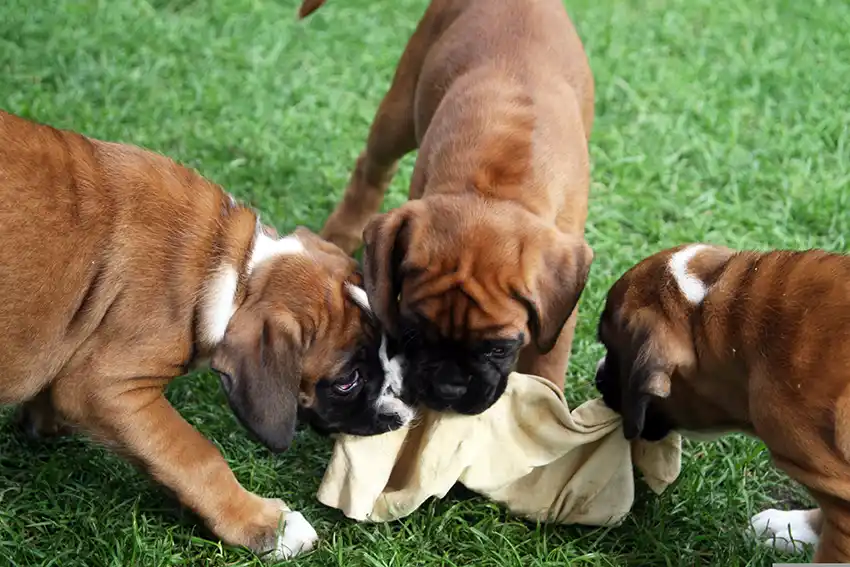
There are many places to acquire a puppy where you can be sure you are getting a puppy that has had the proper breeding. Also, check out your local Boxer Dog Rescues and shelters because they have some amazing dogs and puppies that are desperate for a forever home.
Check out the local breed specific rescues, animal welfare shelters, RSPCA and Dogs Trust, as they have many great dogs looking for homes too, who through no fault of their own, have ended up being abandoned. These organisations test their dogs for temperament and soundness.
By adopting, you will be helping a dog in need, one that wants nothing more than to be in a loving home. There are too many companion animals euthanised each year and Bark Busters encourages you to visit one first before buying a puppy from a breeder.
When you are selecting a puppy, try to avoid selecting the fearful or over-zealous puppy. If you are at a shelter, consider that the dog might just be traumatised by their surroundings. All those barking dogs cause timid dogs stress and quite often you will see a different dog if you can get the staff to bring him away to a private viewing section for you. Animal Welfare and Rescues do amazing work in trying to save dogs and match breeds to the right owners, so consider that option when looking for a new puppy.
Select the right puppy. One that suits your lifestyle.
Many of our Bark Busters’ trainers volunteer their services at local shelters and rescues to assist in rehabilitating dogs. Bark Busters have saved many thousands of dogs through our volunteer rescue programmes around the world.
If you do decide to go to a breeder, then ensure you view both parents to determine the puppy’s personality and parentage.
View all interaction between the puppies as this will tell you a lot about their personality. Look out for those assertive types if you want a dog that is going to be good family dog that is good with children.
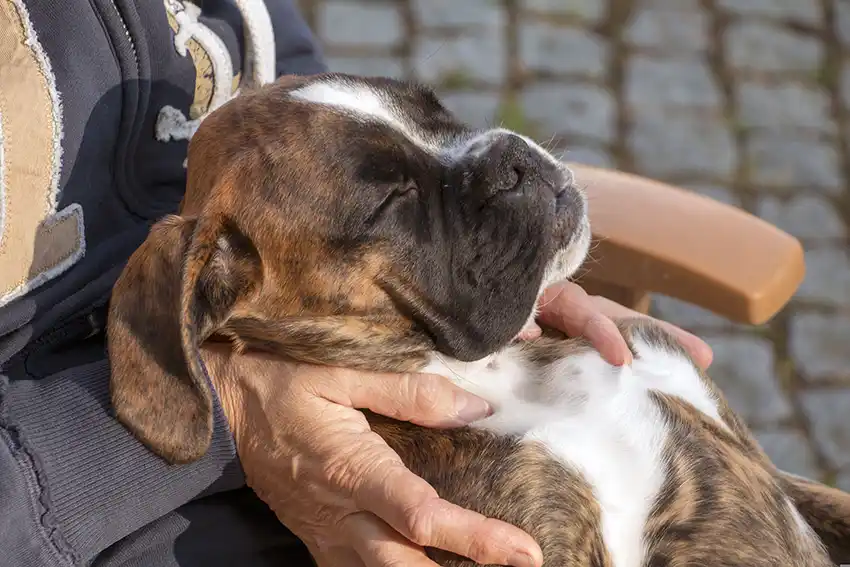
Tips for Bringing a New Puppy Home
Do not bring a puppy home before it has reached 8 weeks of age, but preferably 12 weeks. Any earlier and they will miss out on much needed bonding with other puppies and their mother.
Bring your puppy home early in the day to allow time for your puppy to settle into its new home.
Try to bring some bedding home with the scent of the mother dog, scent of other litter mates, or a familiar scent.
Ensure that you know where your puppy will sleep and introduce your puppy to this area during mealtimes.
If you need to leave your puppy alone for a short while, ensure that you address any barking, while hidden close by, without returning to the puppy. Returning every time your puppy demands, will only encourage more barking. Puppies do better if they know you are there nearby and have not deserted them.
Ensure you have the same diet that your puppy was being fed when with its mother. Any diet change must be a gradual one.
Ensure that you puppy proof your house and place anything dangerous out of harm's way, such as electrical cables and poisonous chemicals.
Make sure you provide lots of bathroom breaks. Take your puppy to do its business at least 8 times per day, after sleeping, eating, drinking and any exuberant exercise.
Do I Want One Dog or Two?
We are often asked by prospective dog parents if they should get one or two puppies. We always answer the same way. Get two only if you really want two dogs!
Dogs are pack animals, and they love having company, but the selection of two dogs is something that must be carefully thought through.
Two neutered males can cohabit without too many issues if their doggie parents treat them equally and do not display any favouritism. Unequal treatment is usually behind most Sibling Rivalry cases.
A male and a female of equal energy can also cohabit. This can be the best match, providing that the female and male are equally matched in size. If they are differing sizes, its best that the male is the larger of the two. Make sure that the female is neutered, when appropriate, or problems could occur if a large male tries to mate with a smaller female.
Two females are not always the perfect pair, as females invariably want to rule the household. It won’t be long before they test each other, and some females won't back down. When you have two females in a household, they both might try to be the boss of each other, which can lead to fights.
Toilet Training
Without a doubt, toilet training a puppy has its challenges and can try your patience. You need to be observant and begin as soon as the puppy is home with you. Bark Busters will make sure the process is not stressful for you or your puppy.
When puppies are first born, they relieve themselves in their den, but their mother is there to clean them. Therefore, there is no scent of urine or faeces where the puppies eat, sleep and play. As they get slightly older, they learn to imitate the mother when she goes outside. This way the puppy becomes conditioned to never eliminate in their dens. If you are crate training, you will find that puppies will avoid toileting in their crate at all costs.
Knowing when your puppy is likely to relieve themselves by reading their body language is the key to success.
Have you ever taken a puppy outside for a walk only to find they relieve themselves as soon as they get back indoors? To avoid this, walk the puppy directly to the area you have designated the toileting area. Stand still and stay with the puppy, so they no longer show interest in you. Do not sit down as this will only encourage the puppy to jump on you and forget what they are there for. Praise when they perform. NEVER scold or rub their nose in any mistakes. This is cruel and will teach your puppy to move out of sight or wait until you are not watching.
Your puppy does not possess human logic but will begin to form good habits through structured routines. Positive reinforcement when they do the right thing in the right place is the best and quickest toilet training method.
Four Basic Needs
Let's examine those four basic needs and why your dog needs them to keep it healthy, balanced and content.

Food - diet / nutrition
Some dogs can be pretty picky about their food. Consult with your veterinarian about which brand of food you should purchase, or which raw diet is best for your dog. Your dog's diet is important to meet his nutritional needs and to maintain his overall health. For puppies, as they are so small, you don't need a lot of food to fill them up!
We promote a diet that is grain free, low in carbohydrates and without any harmful e-numbers, colours and preservatives. Carbohydrates do add energy that the dog needs to burn off and can make an already hyperactive dog more active.
The right diet, grain free and filled with fruits, vegetables and raw meat will have advantages to how your dog will feel, look and act.
If you want to understand why grains can make a dog more energetic, you only need to think of racehorses and how their trainers give them grain to get highly energetic racehorses. Energy in, equals energy out.
Bark Busters dog trainers are not vets or dietitians, so we urge you to do your own research into the best diet for your dog. A diet that you will be comfortable with.
We do however have vast experience of how highly concentrated grain diets effect behaviour and can cause hyperactivity. This is very prominent in Japan, where most dogs are fed high levels of rice in their diet which can adversely affect concentration and focus.
Safety - through leadership and education
All dogs need strong leadership and to know where they fit into the family unit. If they know they have a leader that will make all the decisions, one who is fair and just, they will be happy and content.
On the other hand, if they have no structure in their life, they have inconsistency, and don’t know how things will be from one day to the next, then they will become stressed and may experience health ailments, skin and stomach issues and behaviour problems. Routine and respect must be established. With equal doses of love and structure your dog will feel safe and secure.
Your dog just wants to please you but many times he doesn't know how. If you don't quickly establish yourself as the leader, a Boxer will gladly assume this role and chaos could follow.
Shelter - a place to call their own
Dogs love nothing better than to curl up on the couch or in a place they can call their own, even when there is more than one dog. Most dogs are very sociable, and they will think nothing of all snuggling in together. Provide your dog with its own "den", a place where they can call home, and somewhere they can go to for a bit of peace and quiet. Just make sure their "den" is warm, easy to clean and maintain. Also, this breed does not like to be cold, and their shivering is a sign that some warmth is needed.
Entertainment - toys & games
A very important part of your dog's four basic needs is their need to have something to do. If we want to avoid our pets becoming bored and destructive, then they need a way to fill their day.
Dogs thrive with physical and mental exercise. Dogs are highly intelligent animals, and they need to keep their brains active as much as their bodies. Entertainment is an important part of their well-being and essential to your dog's overall mental health.
One great toy is the Bark Busters GameChanger® which helps to prevent boredom, stress, and separation anxiety. By filling it with small treats, your dog will have plenty of fun trying to get the treats to dispense.

Games to Play
’Tug of War’ is okay, and playing ball is good, provided your dog is not the type that gets fixated on the ball and refuses to stop playing when requested. Hide and seek is a great game too. These are games where you hide things from your dog, toys or a tennis ball and then encourage them to find the items. You can increase the degree of difficulty as your dog gets better at the game.
Start out where your dog sees you hide the toy, then repeat over and over like 'Find or Seek'.
Remember to give a lot of praise when they find it. These type of games are more calming for your Boxers, than those type of games that encourage your dog to become over-excited.
Child’s Play
Boxers are great family dogs but they do need to be controlled around children or they might hurt them with their overexcitment. They do learn quickly, so spend time educating them on what is good and what is not. If you are patient and understanding of their capabilities, you will be able to enjoy many great times, as a family, with your dog.
Interactive Toys
Bark Busters has the ultimate toy for all dogs that provides dogs with several options. The GameChanger® by Bark Busters is an interactive puzzle toy that delivers a treat. It's a chew toy, that they can carry around and take to their bed. They can't rip it apart like many other toys. It's a workout toy, that they flip over with their nose and scratch it with their paws. The GameChanger® comes in four vibrant colours and will give your dog lots of fun and mental stimulation.

Agility and Flyball
Agility or flyball is a great game to play with your Boxer. They are not known for this type of activity, but they do throw their full effort into it. Agility keeps your dog focused and is a great way to reinforce your commands to your dog. They will listen out for your commands and direction which is also great in eveyday life and dangerous situations too. It is important that your dog listends to your commands if it gets into danger, and these games are great way to reinforce this.
Agility and flyball events are held up and down the country from local to county, to national championship levels. Not only is it enjoyable for your dog, but they are great events for all of the family too. It's ideal for the competitive person and those who just like a bit of fun too.
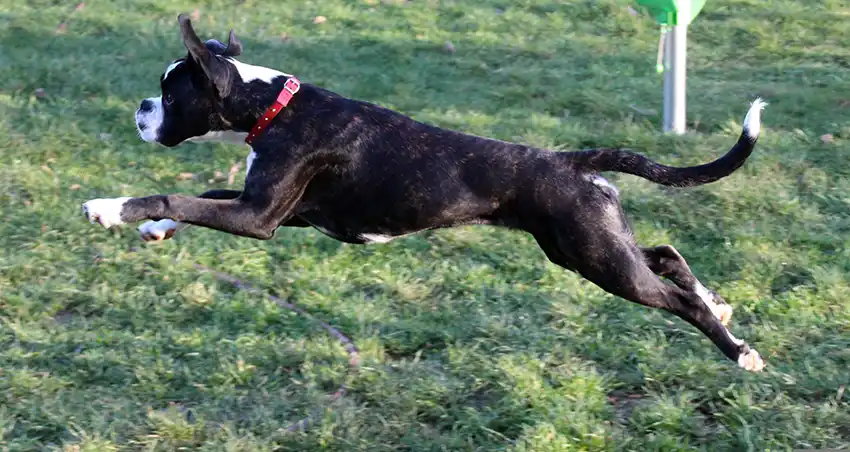
Dog Parks
With today's dog owners having such busy lifestyles, more and more dog owners are turning to dog parks as a way of socialising and exercising their dogs. While this is great fun for most dogs and dog owners, not every dog will do well in this environment.
Breeds like Boxers are incredibly high energy and love to run and crash into other dogs. While this sounds like a perfect match for a dog park, owners must pay close attention to how their dog directs its focus. If your dog is allowed to run wild, your dog will likely have high levels of adrenaline. While adrenaline can be helpful, if your dog becomes too focused on the wrong target in the dog park, this could quickly turn into a problem. If a dog doesn't enjoy being chased and crashed into, they could feel threatened and become agitated. While the Boxer is just being a Boxer, if the other dog feels threatened and turns on them, this could escalate into a fight. As the dogs have no prior relationship and are in a high stress environment, this can easily happen.
The best way to prevent this behaviour is to be sure you have strong voice control over your dog in low, medium and high level distraction environments before attempting to visit a dog park. Try visiting the dog park in off peak hours and practice gaining focus from your dog before you allow them to run off and play.
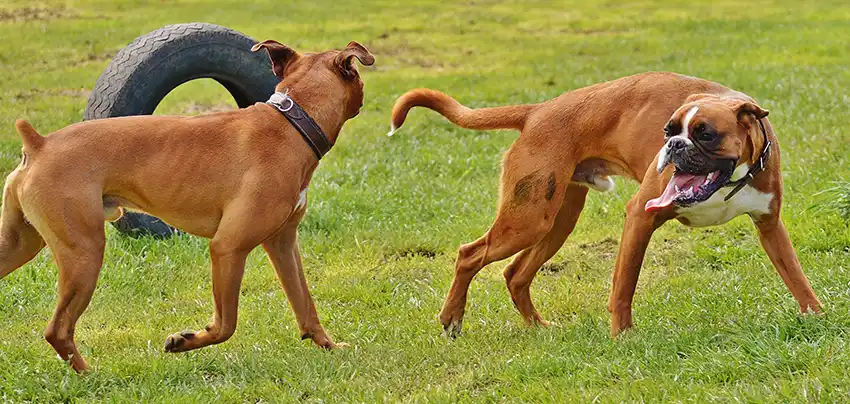
Bark Busters Lifetime Support Guarantee
Bark Busters dog behaviour therapists and trainers have trained more than 1 Million dogs worldwide and are renowned authorities in addressing dog behaviour with all-natural, dog-friendly methods. The Bark Busters training is the only service of its kind to provide International dog training guaranteed lifetime support. With hundreds of trainers around the world, Bark Busters continues its mission to enhance the human/canine relationship and to reduce the possibility of maltreatment, abandonment and euthanasia. Contact your local Bark Busters dog trainer to see how they can help.
This article is the copyright of Bark Busters® and is intended for information purposes only. Dog owners should fully research any problems that they may have with their dogs.

